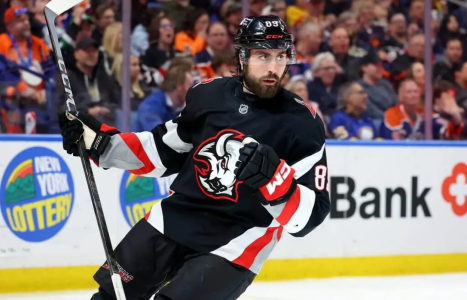
Sabres summer thoughts: On Alex Tuch, the lingering cap space question and more
The Sabres’ offseason activity might be complete, but there is time for things to change before training camp.

The Buffalo Sabres’ offseason activity might be complete. After signing Conor Timmins and Devon Levi, the Sabres don’t have any restricted free agents remaining. They have 23 roster spots filled with enough players on the organizational depth chart at all positions.
The Sabres also don’t open training camp until mid-September. There is time for things to change. But here are some leftover summer thoughts on Buffalo’s roster as it stands today.
Is cap space really an issue?
The Sabres have $5.2 million in salary-cap space, according to PuckPedia. If that figure holds on opening night, it will be the sixth consecutive season the Sabres have entered the season with at least $5 million in cap space. And it’s worth pointing out that the Sabres are carrying a $4.4 million dead cap hit from the Jeff Skinner buyout. So the real spending is lower than the total cap hit.The Sabres’ lack of player spending has been criticized in recent seasons, and that’s been fair. According to Spotrac, the Sabres had more than $8 million in cap space in 2024-25, more than $10 million in 2023-24, more than $17 million in 2022-23, more than $15 million in 2021-22 and more than $8 million in 2020-21. The salary cap was flat for most of that time, so the lack of spending was a real issue and one that held this team back.
I’m not quite as hung up on the $5 million in cap space remaining this summer for a few reasons. One is that half that number puts the Sabres right in the middle of the league in cap space. A few teams could pass them some late-summer signings, but the Sabres aren’t down near the bottom of the league in spending. The rising cap and lack of available players in free agency have created quite a few teams with plenty of money but nobody left to spend it on. And that’s the second reason the cap space isn’t as glaring an issue this summer. The Sabres and the rest of the league didn’t have a lot of options in free agency. It wasn’t a great class, and a lot of the best players stayed put. We already know Buffalo isn’t a free-agent destination to begin with, so Mitch Marner and Nikolaj Ehlers weren’t realistic targets.
The Sabres’ lack of spending under general manager Kevyn Adams is more of a multi-season issue than it is a 2025-26 issue. The summer of 2023 was a major missed opportunity when it comes to adding to the roster. Last summer, the Sabres bought out Skinner and didn’t spend the cap savings. Adams’ explanations over the last few years have ranged from not wanting to block young players in the lineup to wanting to save money for future restricted free agents. Whether it was internal penny pinching, bad strategy or lack of foresight, spending has been a major problem over the last five seasons.
But now? The Sabres have just over $5 million in space. That’s enough to make a late-summer trade if an opportunity arises. It’s enough to comfortably make an in-season trade, too. Whether Adams can make those types of moves remains to be seen, but the cap space question isn’t as pressing as it was the last few seasons. Now it’s about whether Lindy Ruff can get the most out of the group that he has
Devon Levi’s contract and the goalie picture
Levi getting a two-year contract worth just $812,500 per season is a team-friendly number. It gives Levi, who hasn’t yet become a full-time NHLer, a chance to prove himself before signing a longer deal. After starting the last two seasons in the NHL, Levi played 50 games in the AHL between the regular season and playoffs last season. Goalie development coach Seamus Kotyk said this summer that more time in the AHL wouldn’t be a bad thing for Levi. The Sabres’ addition of veteran goalie Alex Lyon was a strong indication that they don’t want to force Levi into the NHL again. He can still go to the AHL without waivers until he plays 21 more NHL games, so waivers shouldn’t be a concern this season unless an injury forces Levi into action. Levi turns 24 at the end of December, so this isn’t the time to push the panic button on his development. Another strong season in the AHL should help him have a better chance to step in as a full-time backup in 2026-27. The Sabres need stability in net this season, and it’s hard to say whether Levi can provide that yet.What’s interesting is what the Sabres’ goalie picture will look like beyond this season. Lyon is on a two-year contract that matches Levi’s two-year term. Ukko-Pekka Luukkonen has four years left on his contract. By the time Levi is ready for his next contract, the Sabres should have a clearer picture of what they have in both Luukkonen and Levi and can plan their goalie situation accordingly.
